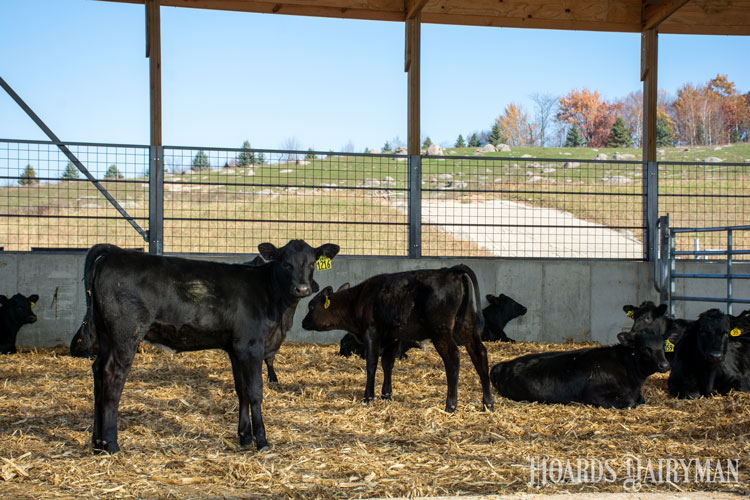
Diversifying income on a dairy can hold the key to financial success though low milk prices. Domestic beef semen sales have climbed over 300% in the past five years, with 9 million units sold in 2022 according to the National Association of Animal Breeders. This exponential growth in beef semen sales suggest that dairy farmers are exploring the possibility of becoming more active in the beef industry to diversify gross receipts.
With all these beef matings, we’ve collectively learned through trial and error ways to manage the offspring — but what about the dam? In the end, a dairyman’s goal is to reset this cow and start shipping the milk down the road.
“We set out to learn if these matings have any negative implications on your cow herd,” explained Bailey Basiel, a doctoral candidate from Penn State University, on this month’s “Dairy Science Digest” podcast. “I’m happy to report that using beef sires on your dairy herd isn’t going to hurt your herd of high-producing dairy cows,” she continued.
The project, summarized in the November edition of the Journal of Dairy Science, utilized a dataset of mature Holstein cows from 10 participating herds across the nation with herd sizes ranging from 100 to 13,000. Management of beef-on-dairy breedings varied between operation with matings from Angus, Brahman, Charolais, crossbred beef, Hereford, Limousin, Simmental, Shorthorn, Red Angus, Red Brahman, and Wagyu. More than 75,000 matings were assessed over 39,000 lactations.
Beef breed effects on gestation length
Purebred Holstein matings routinely gestate for 277 days. “We’ve seen this slide from the historical 283 days due to improved calving ease and increased use of sexed semen,” said Scott Poock, University of Missouri Extension state dairy veterinarian. However, this project has illuminated that when dairy cows are bred to beef, the gestation length could change.
Gestation length is influenced by calf sire breed. The average days to calving were found to be:
Breed | Gestation length (d) | Breed | Gestation length (d) | |
Angus | 278 | Limousin | 282 | |
Charolais | 280 | Simmental | 280 | |
Crossbred beef (XB) | 279 | Wagyu | 285 | |
Holstein | 277 | Other | 280 |
Most notably are the longer Limousin and Wagyu gestations. An additional five to eight days is enough for dairy farmers to consider management changes. This may include strategically allowing these dams to remain in the milking herd for an additional week or delaying the transition into the close-up pen.
“Admittedly, this wasn’t even in the initial research question, but we got a call from the field,” explained Basiel. A dairy producer breeding to Wagyu reached out to Penn State Extension to see if they had heard anything about long gestations in Wagyu. “He had been inducing calving when cows were two weeks overdue,” she continued. “So, we set out to learn if this was a fluke or a biological effect of those calves needing just a little more time.
“Delaying dry-off puts an extra week of milk in the tank and delaying movement into the close-up pen prevents a prolonged exposure to the most expensive ration on the farm,” encouraged Bluel. “These are both net financial benefits to understanding the biology of these breedings, in addition to the high-valued calf.”
Knowing that gestation could be longer, the first thought that likely comes to mind is, “Will that big calf cause trouble: dystocia, stillbirth, or retained placentas?”
“No,” Basiel simply stated. “While there was a slight increase in stillbirth risk in the crossbred beef category, we found no effect on dystocia risk.” The health of the cow was also not compromised. “We studied metabolic events, reproductive events, mastitis, and lameness and still found nothing different with the cows bred back to beef,” Basiel added
If you’re not already using beef semen on the bottom of your herd, consider this a green light. Using beef sires on your dairy herd isn’t going to hurt them. This will allow a “reset” on an aged cow to get the cow’s milk back in the tank but not perpetuate her genetics. The accelerated genetic improvement will be visual in the herd in short order.
Next research
There’s interest in creating a genetic evaluation for sires selected for beef-on-dairy matings. Quality on-farm record management holds the key to advancing sire selection forward. Researchers are eager to better understand what is happening developmentally in utero that results in these calves having a slightly longer gestation.
“I’d like to see a Predicted Transmitting Ability (PTA) for gestation length and dystocia for these sires,” suggested Basiel. “While we don’t yet understand the why, at least we can manage for it.
To learn more, listen in to the monthly podcast, Dairy Science Digest on your favorite podcast platform.








